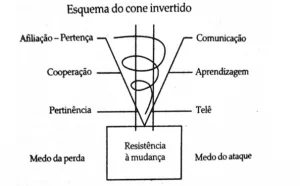ORIGINAL ARTICLE
FRANÇA, Maria Cristina Cavalieri [2], SILVA, Carlos Roberto Ferreira da [3]
FRANÇA, Maria Cristina Cavalieri. SILVA, Carlos Roberto Ferreira da. Built identity: Place of psychodiagnosis in the construction of man in the concept of himself and its future implications. Multidisciplinary Scientific Journal Núcleo do Conhecimento. Year 06, Ed. 01, Vol. 07, pp. 102-111. January 2021. ISSN: 2448-0959, Access link: https://www.nucleodoconhecimento.com.br/psychology/built-identity
ABSTRACT
This article aimed to identify what are the possible implications of the psychodiagnosis based on the ICD 10, regarding the construction of the image of oneself according to the Person Centered Approach. That said, it was developed through bibliographic reviews and also presents a mention of a clinical case that allowed us to highlight the possibility of a framework favoring an illness and, not only, giving itself to the indication of a treatment, so that it is carried out through a reflective survey, taking necessary care so that the psychodiagnosis does not interfere in the process of the tendency to self-update the patient involved.
Keywords: Psychodiagnosis, framing, self-updating.
INTRODUCTION
The diagnostic activity aims to evaluate a person to understand the moment he is going through. In Psychology, this activity has stages: it starts with an interview; then, the process develops from the application of psychological tests and techniques and ends with the return, which may happen with one or more final interviews (OCAMPO; ARZENO; PICCOLO, 1981). As for the final interviews, also called devolution stage, Almeida (2004) affirms that it is necessary to know how to deal with the anxiety emerging from the process carried out, seeking clarification for the gaps in some statements and taking the initiative in times of impasse. Thus, it is possible to infer that anxiety disorders have been a state frequently observed in this stage, and that, in this process, gaps and impasses that will become part of the person’s life may occur in addition to the symptoms that have been mapped up to the moment before the return .
When carrying out the bibliographic research on the theme proposed in this work, it was possible to verify that the aspects addressed during the delivery of results are generally restricted to technical elements. The dimension of the client, who is the person most interested in this process, has not been taken into account at this point in the psychodiagnosis. It is relevant, then, to discuss and analyze the issues that go beyond the technique and that happen in the internal world of the client at the time of the delivery of the psychodiagnosis and pay attention to the professionals for this possible negligence. Thus, it is believed that this argument consolidates a pertinent justification for the realization and development of this work.
When reflecting on what this step may mean for a person, the objective of this article is to map through fragments of a clinical case the relevance of the information conveyed at the time of the return of a psychodiagnosis and its future implications for a person from a framing in the ICD 10 with regard to the construction of the image of itself and the process of self-updating.
MENTAL DISORDER AS A DISEASE
In our culture, the medical point of view always imposes itself as to the regulation and control of the concepts of health and disease, pointing more and more to the medicalization of mental health. Rosemberg (1998) points out that the word of a health professional has the weight of the verdict. We work with the concept of healthy and sick and these provide generalization excluding the heterogeneous and the different. Therefore, we need to consider that:
The diagnosis, understood as nosography, is not aimed at understanding the patient, addressing his subjectivity, but is named as a way to crystallize suffering in a classifiable mental illness, with the obvious consequence of making the patient’s singularity disappear. (ROSEMBERG, 2015. p.1)
Thus, if the diagnosis has the weight and power of a verdict, it can be decisive in this disappearance of the singularity.
According to Rosemberg (1998), diagnosing means gathering a series of evidence that allows to approach the mode of operation and the origin of certain clinical manifestations, interpreting and constructing hypotheses that allow to account for the symbolic work, along with the conflicts that are structured in the way of construction of the subjectivity. In the field of medicine, diagnosing means classifying diseases, whether physical or mental, based on the assumption that a limit has been established between normality and pathology. Naming and classifying seem to present themselves as fundamental, since, when a body has symptoms, one immediately asks: what does that body have? There is a look filtered by the Cartesian paradigm that points to a body that has a disease and in which there seems to be no person (subject) that inhabits it.
In the case of a psychodiagnosis, Augras affirms that the definition of a purely statistical normal “must be dismissed for neglecting the qualitative aspects of behavior and lending itself to the caricature of the petty-bourgeois normal” (1996, p. 21). Goldstein points out that the disease is the “obscuration of existence”, insofar as:
[…] The individual responds inadequately to a given situation, putting his own survival at risk. Health is not a state, but a process, in which the organism is updated together with the world, transforming it and giving it meaning as it itself changes. (GOLDSTEIN apud AUGRAS, 1996, p. 11).
It is important to emphasize that it is not a question of criticizing or condemning a traditional diagnosis of mental disorder, but raising questions about its impact on the people who receive it, and that it may come to be understood and identified by the abnormality filter preventing the flow of updating and overcoming. What we are questioning is that currently psychiatry and even patients themselves are in a hurry to classify feelings of discomfort, such as illnesses, which often end up closing the flow of life and / or distorting the notion of themselves, compromising the tendency self-updating. There is a singularity in the report of each person and categorizing him, labeling him, can define a sick way of going around the world.
According to Rogers (1992), there is a type of risk when a client feels that his measure of personal value is in the hands of another person since:
The psychological examination implies, through the deposition of adaptive and sick parts of the patient in the psychologist, a process in which his identity is attacked, requiring an internal reconnection between certain aspects that the subject recognizes as his (manifest identity) and others that he does not know, but acts (latent identity). (OCAMPO, 1981, p. 316).
It is verified, then, that the client’s knowledge process takes place in a field in which variables of both therapist and client / therapist intervene. In the phenomenological field of the client, he would be in the position of “not knowing” and the therapist in the position of knowing about him (client). With regard to “not knowing” the patient is in a vulnerable place, an ideal scenario for a possible loss of identity.
MAPPING OF THE IMPLICATIONS OF THE RETURN ON ANA’S REPORT THAT REFER TO THE RECEIVED PSYCHODIAGNOSIS
Ana, aged 46, sought therapeutic help reporting that she had used the drug Escitalopram for eight years, for the treatment of Panic Syndrome, and that, for seven years, she no longer has any symptoms from which she made her see the psychiatrist. Her therapeutic demand was to withdraw the medication, but she did not have the courage to do so, despite the fact that her psychiatrist released her to do so. She, in turn, did not trust her body without the medication. She reports that at the age of 17 she had a serious physical injury in an accident, when she had symptoms that were classified in ICD 10 as Panic Syndrome. At the time, she was treated with antidepressants and referred to psychotherapy. After this event, whenever she felt any manifestation of anxiety she believed she was facing the previous diagnosis. She was looking for a psychiatrist and was medicated again.
Ana reports that, since she became aware that she had a disease called Panic Syndrome, she stopped trusting her physical body since it “played tricks on her”, with no predictable place, time and context to happen. What she felt took on a name and took on a life of her own: she said it was something that happened, despite her. According to her, the manifestations of anguish and anxiety appeared in abrupt, unexpected and uncontrollable ways and, for this reason, her behavior became always avoidant and she wondered when the next panic attack would be. She started to perceive herself about the filter of the received label and, before that, she suffered a conflict between what she perceived of herself and what was expected to be what she presented through her symptoms. The symptoms stuck to the image that Ana had of herself, and thus, caused a rupture in her self-perception and started to be based on an image constructed for her: a limited, vulnerable and sick person.
Rogers states that: “Human beings have the capacity, latent or manifest, to understand themselves and to solve their problems sufficiently to achieve the satisfaction and effectiveness necessary for proper functioning.” (ROGERS; KINGET, 1977, p.39).
With outsourcing to a psychodiagnosis to build knowledge about oneself, this latent or manifest capacity described by Rogers is displaced outward and will tend to compromise the proper functioning to solve the problems that life presents.
A diagnosis can bring a person a pseudo understanding of himself, an understanding that is formulated through condensation, a label that, in a nutshell, defines a way of being and being in life’s experiences. Ana affirms that the panic disorder was received as a condemnation to no longer have an adequate psychic functioning. She started not to trust her body, her mind and found herself unable to relate safely. She reports that before the psychodiagnosis she had the impression that “one hour it would end:“ like a flu that comes, drops and passes ”. And, after receiving the psychodiagnosis, she reports that she became panic, and no longer has any manifestation of disharmony. Ana, when given the appointment of her scientifically defined discomfort, closed herself off and defined herself as an incapable being. The label has become a threatening ghost and seems to have interrupted the natural flow of self-updating.
Rogers (1992) affirms that the tendency to update the Organism presides over the exercise of all functions, both physical and experiential and constantly seeks to develop the individual’s potential to ensure its conservation and enrichment, taking into account the possibilities and limits middle, and affirms that if there are no serious disturbances this will happen in the direction of maturity and proper functioning.
There is no doubt, in the case presented here, that both the physical experience (injury) and the psychodiagnosis (phenomenon) that Ana experienced took on the guise of serious disturbances.
DISCUSSION: CONSTRUCTING YOURSELF AND PSYCHODIAGNOSTIC IMAGE
The construction of the image of the self or the notion of the self, according to Rogers, is an organized and changing set of perceptions related to the individual himself that include “characteristics”, attributes, qualities and defects, capacities and limits, values and relationships that the individual recognizes as descriptive of himself and that he perceives as constituting his identity (ROGERS, 1977).
Ana went through two limiting disorders: physical and psychological injuries. These two limitations were added to her construction of her notion of me that resulted in the failure of the updating trend process:
When the notion of the self has gaps and errors, the actualizing trend will not be clear; it will propose goals that are difficult to achieve, if not feasible and – the same circumstances are repeated – it will end in failure, with all the frustrations that result from it and that hamper the proper functioning. (ROGERS; KINGET, 1977, p.39)
From the diagnosis, Ana began to perceive the world from a sick prism of her self, and this is justified by Rogers’ note when she affirms that it is “the notion of the self that, in the final analysis, determines the effectiveness or ineffectiveness of the updating trend ” (ROGERS, 1992). Experiential freedom found the limit set by the label and took away from Ana the possibility of returning to trust in herself and in the flow of life. Ana reports that everything she envisioned to be and do was condemned by the certainty of her incapacity: “I became a coward because I believed that I could not trust my body and that it was a structure that manifested in spite of me: an illness.” .
Currently, Ana is still undergoing therapeutic treatment, has withdrawn her medication and has been discharged from her psychiatrist. However, she reports:
I even believe that I will be able to carry out my life and that I can even live without medication, but I always remember the diagnosis and I can’t help thinking: what if this horror comes back? It is as if there is a hidden haunt within me that may surprise me at any moment.
As for this composition of self-reading that Ana built, Rogers (1977) states that “the individual, his tendency to update and his notion of” I “are part of a phenomenological world”.
Humanism is concerned with the person who suffers and who needs shelter to withstand the effects of that suffering. The questions are: what happened to this person to make his body manifest in this way? “What is the functional relationship that exists between this complaint and the individual’s total existence?” (FRAZÃO, 1995, p. 82). What is the reality experienced by this person that has prevented his self-actualization?
Rogers says that suffering happens due to non-acceptance. In this perspective, by placing the phenomenological manifestation of suffering attached to a diagnosis, a subject who has nothing but interruptions in his process of self-actualization can become ill due to the non-acceptance of his way of being, being and attending. world. Without the label, it is believed that Ana could go through suffering without the latter defining an image of herself outside the norms of normality. By being welcomed through empathetic understanding, she would be able to fully develop in an environment of acceptance.
The self-image, according to Rogers (1997), has the role of filtering the experiences that will be symbolized and those that will not be. It is formed from personal experiences and can change from relationships with others and with the world. In view of this, at the moment of the return of a psychodiagnosis, the client may choose the professional who does it, as a criterion person and, thus, modify the perception of themselves. A person is understood as a criterion
… Those from whom the subject would like to have an acceptance. Throughout their lives, the subjects elect several people-criteria, exercising these, great influence on those. When a value of a criterion-person is introjected, an inversion of values takes place, as the subject starts to judge as good or bad what the criterion-person judges good or bad, thus shifting the self-assessment center from the internal perception to the criterion’s external dimension. The result of this is a loss of contact with their own internal processes that drive their tendency to development, blocking the individual’s personal growth. (GUIMARÃES, 2010)
For this reason, psychodiagnosis can mean depersonalization for the person who receives it since it is “a limited way of reducing a person to a concept” (ROSENBLATT apud FRAZÃO, 1995, p. 80), as if a body had life without a subject to inhabit it.
Frazão (1995) uses the meaning of the word diagnosis, a day that means “through” and gnose that means knowledge to infer that diagnosis means knowing through. And complete:
I can only know the patient, on the one hand, through himself; through what he himself presents me: his speech, his body, his posture, his feelings and the coherence or incoherence of these aspects; and on the other hand, I can get to know him through my relationship with him. (FRAZÃO, 1995, p. 81).
So, in the face of suffering, in the face of reported symptoms, it is proposed that the person himself say about his history, his sufferings, in a scenario that is unique! It is the person himself who will present himself and use his discomfort as a spokesman who manifests himself, through the symptoms, to say that there is an interrupted flow of life and that is why he is not happy. For this reason, all the relevance is given to the uniqueness of each person and not in the emphasis of his symptoms to present him who he is, pointing out his symptoms as his identity.
CONCLUSION
This research was developed with the objective of raising possible implications of the psychodiagnosis based on the ICD 10 regarding the construction of the image of herself according to the Person Centered Approach.
It made it possible to verify, through Ana’s clinical case, that she started to justify herself and defend herself in order not to be fulfilled in life, assuming that the risks she took when “simply” living, were different from other people, since it was classified under the International Disease Code. Thus, the sensations that she experienced in her body came to have the guise of illness.
From the theoretical references studied, it was found that these diagnostic effects can go well beyond its proposal to discriminate the best way to help this client, since there is a person who receives it and gives it the format of an experienced phenomenon . It was revealed that a psychodiagnosis can interfere in the process of the tendency to self-update causing a negative impact on the construction of the concept of oneself.
In this sense, it is expected to have raised a reflection on the scope of a psychodiagnosis and the necessary care when performing it so that it is not an imposition given by a classification that reduces the notion of the self to symptoms and causes a rupture in the process of self-updating.
REFERENCES
ALMEIDA, N. V. (2004). A entrevista psicológica como um processo dinâmico e criativo. Revista de Psicologia da Vetor, 5(1), 34-39.
AUGRAS, Monique. O ser da compreensão: fenomenologia da situação e de psicodiagnóstico. Petropólis, RJ: Vozes, c1978. 96 p.
FRAZÃO, Lílian Meyer. Revendo a Questão do Diagnóstico em Gestalt-Terapia: Entendidos e Mal Entendidos. Trabalho apresentado no I Encontro Goiano de Gestalt-Terapia, Goiânia, 1995.
GUIMARÃES, Suzana Ferreira. A Modificação da Auto-Imagem: das pessoas critério à psicoterapia. Disponível em: http://docplayer.com.br/6279750-A-modificacao-da-auto-imagem-da-pessoa-criterio-a-psicoterapia.html Acesso em: Novembro de 2015.
MARINHO, Bertani. A auto-imagem e o Processo de Auto-realização. São Paulo: Insight– Psicopedagogia, 1994.
OCAMPO, M.L.S. e cols. A entrevista de devolução de informação. In:______ . O Processo Psicodiagnóstico e as Técnicas Projetivas. São Paulo: Martins Fontes, 1981. Cap. 9, p. 313-333.
ROGERS, Carl. Três questões levantadas por outros pontos de vista: transferência, diagnóstico, aplicabilidade. In: ______ . Terapia Centrada no Cliente. 2 ed. São Paulo: Martins Fontes, 1992. Cap. 5, p.227-265.
ROGERS, Carl R.; KINGET, G. Marian. Psicoterapia e relações humanas: teoria e prática da terapia não-diretiva: vol. 1: exposição geral. Belo Horizonte: Interlivros, 1975. 288 p.
ROMERO, Emilio. O inquilino do imaginário. 3. ed.São Paulo: Lemos, 2001. 331 p.
ROSEMBERG, Ana Maria Sigal. Provocando o Inconsciente. Disponível em: http://www.oocities.org/hotsprings/Villa/3170/AnaMariaSigalRosenberg.htm. Acesso em: Setembro 2015.
[1] This text was presented as a Conclusion Paper for the Psychology Course at Universidade FUMEC, in the 2nd semester of 2015. Emphasis: clinical partner.
[2] Graduation in Psychology and post-graduate student in Behavioral Cognitive Therapy.
[3] Advisor. Ongoing specialization in Humanistic Psychotherapy: ACP. Degree in psychology.
Submitted: November, 2020.
Approved: January, 2021.




